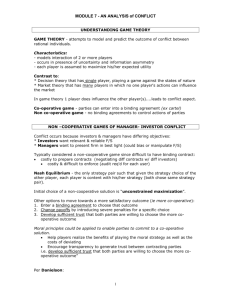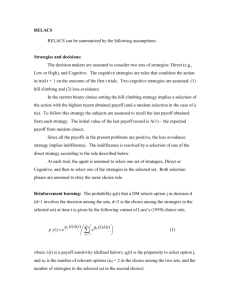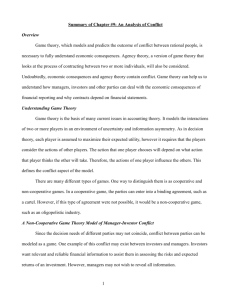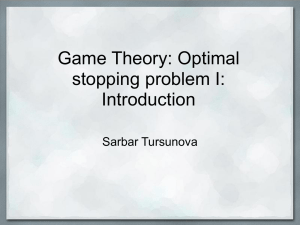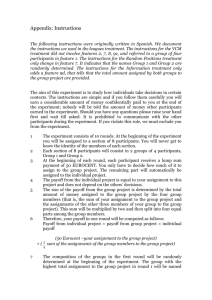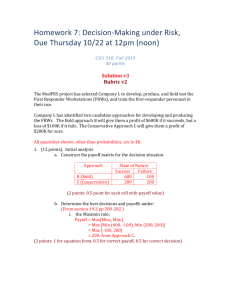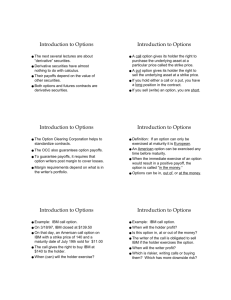Chapter 9 group 4
advertisement
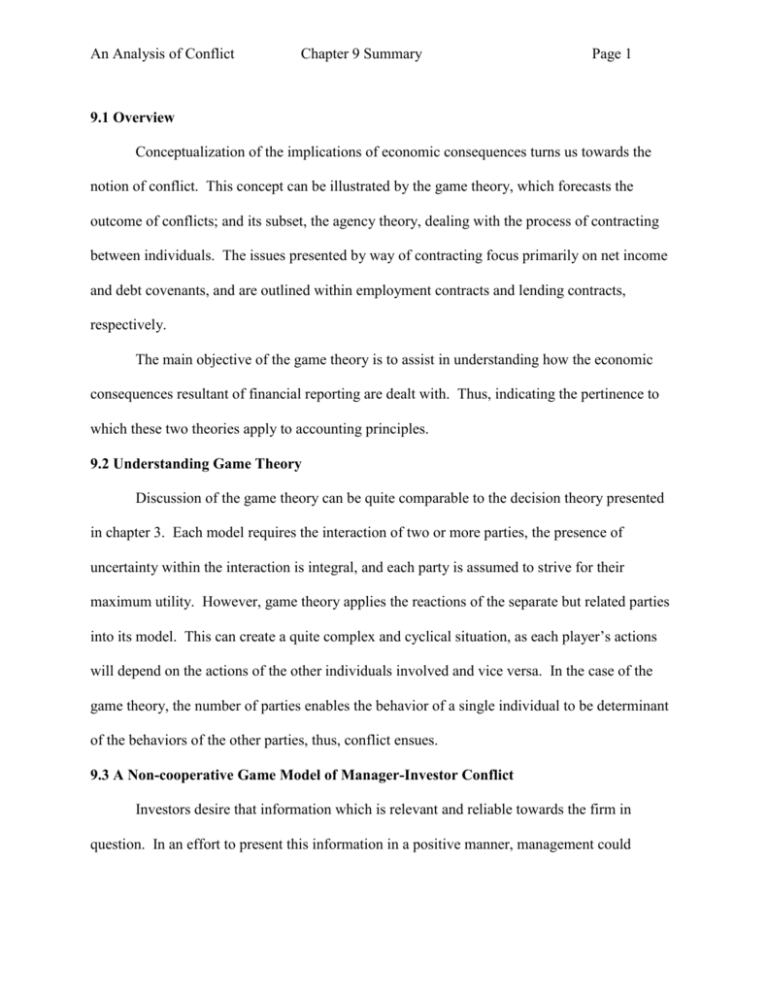
An Analysis of Conflict Chapter 9 Summary Page 1 9.1 Overview Conceptualization of the implications of economic consequences turns us towards the notion of conflict. This concept can be illustrated by the game theory, which forecasts the outcome of conflicts; and its subset, the agency theory, dealing with the process of contracting between individuals. The issues presented by way of contracting focus primarily on net income and debt covenants, and are outlined within employment contracts and lending contracts, respectively. The main objective of the game theory is to assist in understanding how the economic consequences resultant of financial reporting are dealt with. Thus, indicating the pertinence to which these two theories apply to accounting principles. 9.2 Understanding Game Theory Discussion of the game theory can be quite comparable to the decision theory presented in chapter 3. Each model requires the interaction of two or more parties, the presence of uncertainty within the interaction is integral, and each party is assumed to strive for their maximum utility. However, game theory applies the reactions of the separate but related parties into its model. This can create a quite complex and cyclical situation, as each player’s actions will depend on the actions of the other individuals involved and vice versa. In the case of the game theory, the number of parties enables the behavior of a single individual to be determinant of the behaviors of the other parties, thus, conflict ensues. 9.3 A Non-cooperative Game Model of Manager-Investor Conflict Investors desire that information which is relevant and reliable towards the firm in question. In an effort to present this information in a positive manner, management could An Analysis of Conflict Chapter 9 Summary Page 2 engage in biasing or manipulation of financial statements and information. As a combatant towards this possibility, investors consider the implications of this conflict. This situation could be known as a non-cooperative game. A non-cooperative game assumes each party has complete information about the other, however the strategy decision adopted by each is unknown. A utility matrix comparing management’s strategy to distort or be honest of information and the investor’s choice whether or not to purchase the firm’s shares can be constructed. The Nash equilibrium states that the predicted outcome of the strategy pair would be to distort/refuse to buy; thus resulting in the lowest possible utility. Only the invention of a neutral third party could ensure a binding agreement of a honest/buy shares strategy pair. The main objective of the non-cooperative game model is to offer understanding towards the practice of accounting policy choice. Management bodies have their own agenda and certainly may not be willing to adopt a full-disclosure policy with the intention to solely aid investors. As a result of differing objectives between management and investors, conflict arises. Introduction of accounting policies must insure that the implications of them benefit both management and investors, while at the same time offering realistic objectives and avoid economic consequences. 9.4 Models of Cooperative Game Theory This section is divided into two different issues: the contract between a firm owner and manager, and the contract between a lender (bondholder) and manager. The contract between owner and manager has a problem because of what is called goal congruence. If a manager is paid the same regardless of firm performance, the manager has no motivation to work hard because managers are considered to be effort-averse. Therefore, an agency agreement An Analysis of Conflict Chapter 9 Summary Page 3 (employment contract) between owners and managers should help enforce goal congruence. There are five methods mentioned to deal with this agency problem. First, the owner can hire a manager and be satisfied with the lower probability that comes from the manager shirking. Second, the manager can directly monitor the manager. However, it is difficult to observe whether the manager is working hard or not. This would however, result in the first-best contract, meaning that the manager could adjust the payment to the manager based on the direct observation. Third, the owner can indirectly monitor the manager by looking at the state outcome. This only works if there is an observable difference in the low payoff state indicating whether the manager worked hard or shirked. Fourth, the owner could rent the business to the manager for a set fee. This transfers the risk to the manager, which will motivate the manager to work hard. Finally, the most common method is to give the manager a share of the profit. This will result in goal congruence that is cheaper than renting the business to the manager, but provides the same level of motivation. This will result in the second-best alternative. The second issue of agency theory happens between the bondholder and the manager in a lending contract. To set the scene, there is a company that wishes to issue a bond that has 99% probability of repayment if the manager pays no dividends, but only a 10% chance of repayment if the manager decides to pay dividends. There is a 50% probability of either action of the manager if the manager's compensation is indifferent to this action. If the manager's compensation rewards the manager for not paying dividends, then the cost of the bond can be lowered because the probability of repayment is higher. An Analysis of Conflict Chapter 9 Summary Page 4 9.5 Implications of Agency Theory In order to compensate a manager on the basis of a payoff, the amount of the payoff must be observable to both parties. Net income is considered an accurate measure of the payoff since its credibility is insured by GAAP and the audit. An argument against the use of net income as a basis of compensation is that it does not reflect management efforts soon enough, such is the case of research and development department managers. The correlation of management effort and net income is reduced when a manager of a R&D department is penalized for a lower net income even though R&D effort is high. Another weakness of the use of net income is its management through GAAP flexibility. Another suggested alternative to net income is the use of market securities prices. However, since these prices are affected by more that just manager effort, namely external environment influences, it does not seem to be a fair measure of performance. The Holmstrom model states that both are valid approaches to measuring management effort even though each reveal a different form of information. It can be said that market values may be the best source of information for investors and historical cost values for that of managers. Rigidity in contracts arises from incomplete contracts (contracts that do not anticipate all possible state realizations) and difficulties of contract renegotiation (contracts that affect more that two parties). Managers that enter into incomplete contracts due to changes in accounting policies and are unfavourably affected by these changes are likely to take their displeasure out on the accountant that implemented the policy change as opposed to the other party of the contract. An Analysis of Conflict Chapter 9 Summary Page 5 9.6 Reconciliation of Efficient Securities Market Theory with Economic Consequences It can be said that economic consequences and the efficient securities market are consistent since they can be reconciled by positive accounting theory and agency theory. There is nothing about the efficient securities market theory that conflict with management’s concern for accounting policies and vice versa. Together they help us see why managers change accounting policies even though such policies are useful to investors. Possible explanations of economic consequences: Agency theory Managers believe accounting policy choice affects investors decisions Managers accept market efficiency but choose accounting policy Lev’s stock market reaction study tells us that the securities market is inefficient since securities prices go down at the possibility of a policy change and at the same time they may be efficient since the decrease in price can be attributed to the market bidding the price down or a change in the management of a firm An Analysis of Conflict Chapter 9 Summary Page 6 30 Minute Quiz 1. The manager of a Research and Development department that works hard can be penalized by an employee compensation program if effort is to be correlated with net income. a) b) 2. True False If there is no difference in the low payoff to the owner if the manager shirks or not, what method of contract gives the highest expected payoff to the owner (assume that it is impossible to tell by observing whether the manager is working hard or not)? a) b) c) d) Direct monitoring Indirect monitoring Rent the business to the manager Give the manager a share of the payoff Assume the following set of probabilities and payoffs for Questions 3-5: Manager's Effort Work Hard (A1) Shirk (A2) Payoff Probability Payoff Probability High Payoff (X1) $100 0.6 $100 0.4 Low Payoff (X2) $50 0.4 $50 0.6 3. What is the expected utility for the owner, who is risk-neutral, if the manager's salary is fixed at $25 and the manager works hard? a) b) c) d) 4. $55 $45 $60 $75 What would be the maximum that the owner would be willing to invest in controls to ensure that the manager works hard? a) b) c) $12.75 $10 (EU(shirk)=$45, EU(work hard)=$55, 55-45=10) $8 An Analysis of Conflict d) 5. Owner Manager Employee a and b b and c True False (Management compensation directly affects the cost of a bond if the compensation affects the dividend policy of the manager.) Rigidity of a contract arises from: a) b) c) d) e) 9. $7.50 $5.00 $0.60 $1.27 Management compensation has no effect on the cost of a debt issue. a) b) 8. $0 In order to compensate a manager on the basis of a pay off, the amount of the payoff must be observable to the: a) b) c) d) e) 7. Page 7 Assuming the manager works hard, what is the risk premium if instead of the $25 salary, the manager gets 32% of the payoff? a) b) c) d) 6. Chapter 9 Summary lengthy contract periods difficulty of renegotiation incomplete contracts a and b b and c It can be said that economic consequences and the efficient securities market are consistent because they can be reconciled by: a) b) c) payoff tables post-announcement drift theory positive accounting theory An Analysis of Conflict d) e) 10. refuse to buy/distort refuse to buy/honest buy shares/distort buy shares/honest none of the above there is presence of information asymmetry the interaction occurs under uncertainty each player formally takes into account the actions of each other there is an economy wide interest rate a and b a and c a and d b and c b and d c and d Accounting minds have argued that which type of cost basis accounting has properties that make it suitable for contracting purposes a) b) c) d) e) 13. a and b b and c Which of the following does not entail the underlying concepts of interactions within the game theory? a) b) c) d) e) f) g) h) i) j) 12. Page 8 According to the Nash Equilibrium, which strategy pair is the only one that each player will be content with their own strategy choice. a) b) c) d) e) 11. Chapter 9 Summary present value costing market value costing historic based costing successful efforts costing there is no preferable method According to the Game Theory, when parties do not have honest or full disclosure of information between each other, this is what type of game? a) b) c) d) a cooperative game a distorted game a non-cooperative game a non-binding game An Analysis of Conflict e) 14. Page 9 a biased game Game theory attempts to tackle the issue of a) b) c) d) e) 15. Chapter 9 Summary constituencies economic consequences maximum utility conflict contracts The Game theory is a useful model in financial accounting theory because it a) b) c) d) e) states that accounting is a game with a winner and a loser predicts maximum utility of honest and distorted financial statements helps to better understand the process of accounting policy choice supplies information as to the derivation of the Nash Equilibrium offers a matrix of possible strategies between two parties Long Answer 1. Briefly describe the five options that owners have when drafting contracts with managers. Hire the manager and tolerate lower results - Pay the manager the same regardless of the payoff realization. Directly monitor the manager - Pay the manager based on the owner's direct observations. Indirectly monitor the manager - If the low payoffs differ when the manager works hard than if the manager shirks, and the low payoff is realized, payment can be made based on this realization. Rent the business to the manager - This transfers the risk of operation to the manager, because the owner receives the same payment regardless of the payoff. Give the manager a share of the profit - This is the most efficient form of compensation that aligns the goals of the manager with the goals of the owner. 2. Compare Game theory to the Decision theory presented in chapter 3. Game theory models the interaction of two or more players, while Decision theory involves only one individual. Game theory and Decision theory both assume that the player is striving for maximum utility. Both theories operate within situations of uncertainty and information asymmetry. With the Game theory, each party takes into account the actions of the other party while the Decision theory does not. In the Decision theory, payoffs are generated by a random mechanism called nature and cannot be affected by the actions of the investor. Probabilities and payoffs within game theory will undergo change based of the actions of the manager or investor.
